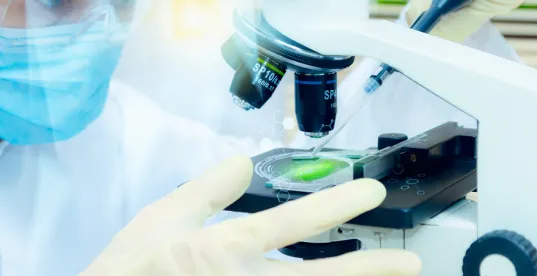On May 22, 2023, the Center for Biologics Evaluation and Research (CBER) at the U.S. Food and Drug Administration (FDA) issued an untitled letter to AT Venture Center for Global Techtrepeneurship, LLC dba Regenerelle, LLC (Regenerelle) for marketing human cells, tissues, or cellular or tissue-based products (HCT/Ps) and exosomes without FDA premarket review. The letter described Regenerelle’s marketing of products derived from umbilical cord as “biological solutions” or “biologic products” that are “intended for a ‘range of clinical applications’ and to treat various diseases or conditions, such as lupus, pain, inflammation, and ‘aging-associated diseases.’” This is CBER’s fourth untitled letter this year, illustrating FDA’s focus on this area of enforcement. This stands in contrast to FDA’s work on the CDER side, where the Office of Prescription Drug Promotion has not issued an untitled letter since June 2, 2022.[1]
Background – HCT/P Regulation:
The use of HCT/Ps and regenerative medicine is “a complex and rapidly evolving field.”[2] To avoid stifling innovation in this area with unnecessary regulatory burdens, the FDA has crafted risk-based regulatory framework that classifies HCT/Ps into different categories based on whether the product meets certain criteria.[3] This initial classification step is crucial for manufacturers to consider as it determines the level of research and development required for the HCT/P product as well as stringency of FDA oversight before the product may enter the market.
As further discussed in our March blog post covering the first CBER untitled letter of 2023, if an HCT/P meets all of the following criteria, then the manufacturer can avoid the time-consuming and costly premarket review and approval process:
-
The HCT/P is minimally manipulated;
-
The HCT/P is objectively marketed for intended uses in the recipient that are consistent with its normal function in the donor’s body (i.e., homologous uses);
-
The HCT/P is not combined with another article (with some limited exceptions); and
-
The HCT/P either:
-
(1) does not have a systemic effect and is not dependent on the metabolic activity of living cells for its primary function; or
-
(2) does have a systemic effect or is dependent on the metabolic activity of living cells for its primary function, and is for:
-
(a) use in the same individual who was the source of the tissue or cells;
-
(b) use in an individual who is a first- or second-degree blood relative of the donor of the tissue or cells; or
-
(c) reproductive use.
-
-
These are commonly known as “361 HCT/Ps.” HCT/Ps that do not meet the above criteria – and do not fall into one of the enumerated exceptions under 21 CFR § 1271.15 – are considered to be drugs, devices, and/or biological products regulated under Section 351 of the PHS Act and the Federal Food, Drug, & Cosmetic Act (FDCA).[4] While 361 HCT/Ps are not required to undergo any FDA premarket review or approval, HCT/Ps considered to be drugs, devices, and/or biological products must satisfy the FDCA’s premarketing requirements.
As aforementioned, this is a risk-based regulatory framework. The FDA has deemed that HCT/P products which meet these four criteria are exempt from premarketing requirements because they present a limited public health risk.[5] In contrast, HCT/Ps that fail to meet these criteria must undergo clinical trials and FDA premarket review and approval in order to gain confidence in their clinical safety and effectiveness. FDA has explained that, for example, when an HCT/P is taken from the donor’s body and more than minimally altered during processing, there is less certainty that the cell or tissue will function the same in the recipient’s body as it did in the donor.[6] And, there are similar concerns when an HCT/P is marketed for some novel use that it did not perform in the donor’s body – i.e., there is little basis to believe that an HCT/P which naturally performs one function will suddenly be capable of a new use, at least absent clinical trials to prove that such outcome is likely to occur.[7]
In determining whether a product complies with the homologous use criteria, FDA will look at the manufacturer’s labeling, advertising, and other representations to determine whether the HCT/P is objectively marketed only for the same uses that it performed in the donor.[8] Furthermore, in enforcing the division between 361 HCT/Ps and those that are subject to the FDCA’s premarketing requirements, FDA prioritizes enforcement for products that present the greatest safety risks based on:
-
The route and site of administration (e.g., those administered by intravenous injection or infusion, aerosol inhalation, intraocular injection, or injection or infusion into the central nervous system present a higher risk); and
-
Whether the product was intended to treat a serious and/or life-threatening disease or condition.[9]
Application – HCT/Ps:
In concluding that Regenerelle marketed unapproved drug and biological products, FDA cited representations made by the firm on its websites and YouTube channel. Such statements included not only descriptions of the company’s products, but also a YouTube video where a chairman of the company stated: “I took our own stem cells myself. I had them injected, infused . . . I now have no pain . . . the meniscus in my left knee has started to rebuild. All of the inflammation is gone, and I have a new life.”
Ultimately, based on the FDA’s review of these statements, the agency found that:
-
The marketed “cellular product derived from umbilical cord appear[ed] to be” an HCT/P;
-
The marketed HCT/P product should not be regulated solely under Section 361 of the PHS Act because they failed to meet the required criteria, including being intended for non-homologous uses, and therefore would be regulated as a drug and biological product; and
-
Regenerelle did not possess a biologics license or investigational new drug application (IND) for its products, in violation of the FDCA and the PHS Act.
In its letter to Regenerelle, FDA directed the firm to its comprehensive regenerative medicine policy framework,[10] which consists of four guidance documents intended to support and expedite the development of regenerative medicine products, including HCT/Ps. Currently, the YouTube video at issue is no longer active, and the firm has revamped its website – removing the problematic claims and adding a lengthy disclaimer.
Exosomes:
Additionally, FDA also addressed the marketing of exosomes, citing a December 2019 Public Safety Notification on Exosome Products. In that notification, FDA stated that “[a]s a general matter, exosomes used to treat diseases and conditions in humans are regulated as drugs and biological products under” the PHS Act and FDCA “and are subject to premarket review and approval requirements.” The agency strongly critiqued the marketing of unapproved exosome products for therapeutic purposes, noting reports of serious adverse events and deceptive claims made by companies regarding the safety and effectiveness of such products. Furthermore, FDA admonished clinics offering unapproved exosome products, stating that they “are taking advantage of patients and flouting federal statutes and FDA regulations,” “delaying treatment with legitimate and scientifically sound treatment options,” and “posing harm to patients.”
Again, citing claims made on Regenerelle’s websites, FDA noted that the company marketed unapproved exosome products, which they “refer to as ‘Extracellular Vesicles (EVs)’ for ‘aging-associated diseases’ and a ‘range of clinical applications,’” in violation of the FDCA, PHS Act, and implementing regulations. As aforementioned, the company’s website is now updated to include a disclaimer and they have removed the problematic statements suggesting that their exosome products treat diseases or conditions in humans.
Takeaways:
As the fourth untitled letter of 2023, CBER is clearly on a roll in enforcing HCT/P regulations, with more untitled letters published in three months than in all of 2022.[11] As noted in our March blog post, this enforcement trend indicates that FDA is keeping a close eye on the promotion of such products and making sure they are properly classified and undergo appropriate premarket review. Moreover, given that every letter has specified that the HCT/P at issue failed to meet the homologous use criteria, it is evident that CBER is particularly concerned with the uses for which these products are being marketed.[12]
Indeed, in looking at FDA’s statements regarding the homologous use criteria, it is unsurprising that these companies have received untitled letters. For example, all of the HCT/P manufacturers made claims that their products were capable of treating a wide variety of diseases and conditions. Regenerelle itself marketed their products as treating a number of diseases and conditions such as “lupus, pain, inflammation, and ‘aging-associated diseases.’”[13] FDA has specifically noted that HCT/Ps intended to treat “a myriad of diseases or conditions” are inherently suspect and indicate that “the HCT/P is likely not intended for homologous use only.”[14]
Adding to this, FDA has also condemned the use of grandiose claims regarding the capacity of untested human cell and tissue products to treat serious and life-threatening diseases. The agency has stated that “promotion of an HCT/P for an unproven therapeutic use, such as curing cancer, would clearly make it inappropriate to regulate the HCT/P solely under section 361 of the PHS Act.”[15] Although of course there are benefits to regenerative medicine, unproven claims regarding particularly novel uses of human cells and tissues can pose dangerous risks to patients that are swayed by such statements and opt for an untested HCT/P over an FDA-approved drug, device, and/or biological product.[16]
Overall, the enforcement trend for 2023 thus far indicates that FDA is taking seriously its role in monitoring HCT/Ps, exosomes, and regenerative medicine and will not allow companies to exploit the 361 HCT/P exemption to avoid FDCA premarketing requirements. Manufacturers in this area should be mindful of the regulations and FDA guidance relating to regenerative medicine when determining an approval and marketing strategy for their product. In particular, given this emerging CBER enforcement trend, HCT/P manufacturers should carefully review their labeling, advertising, and any other representations to ensure compliance with the homologous use criteria.
FOOTNOTES
[1] See U.S. Food & Drug Admin., Untitled Letters 2022 | FDA.
[3] See U.S. Food & Drug Admin., Proposed Approach to Regulation of Cellular and Tissue-Based Products, at 6-7 (Feb. 1997) (“1997 Proposed Approach”).
[4] 21 C.F.R. § 1271.20.
[5] 1997 Proposed Approach, at 6.
[6] See id. at 19; Regulatory Considerations for Human Cells, Tissues, and Cellular and Tissue-Based Products: Minimal Manipulation and Homologous Use, at 7.
[7] See Regulatory Considerations for Human Cells, Tissues, and Cellular and Tissue-Based Products: Minimal Manipulation and Homologous Use, at 4.
[8] Id. at 22.
[9] Id. at 22-23.
[10] Framework available here: Framework for the Regulation of Regenerative Medicine Products | FDA.
[11] See BIMO/Team Biologics/Internet Surveillance/Other | FDA.
[12] See March 1, 2023 Untitled Letter – Thomas Advanced Medical LLC (fda.gov); March 30, 2023 Untitled Letter – Minneapolis Regenerative Medicine (fda.gov); April 3, 2023 Untitled Letter – Fidia Pharma USA Inc. (fda.gov); May 22, 2023 Untitled Letter – AT Venture Center for Global Techtrepreneurship, LLC dba Regenerelle, LLC (fda.gov).
[14] Regulatory Considerations for Human Cells, Tissues, and Cellular and Tissue-Based Products: Minimal Manipulation and Homologous Use, at 16.
[15] 66 Fed. Reg. 5447, 5458 (Jan. 19, 2001).
[16] See Regulatory Considerations for Human Cells, Tissues, and Cellular and Tissue-Based Products: Minimal Manipulation and Homologous Use, at 23.




 />i
/>i

